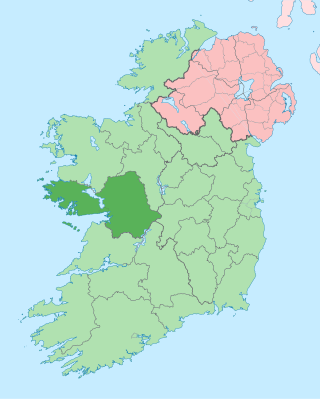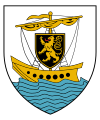
Connacht or Connaught, is one of the four provinces of Ireland, in the west of Ireland. Until the ninth century it consisted of several independent major Gaelic kingdoms.

County Galway is a county in Ireland. It is in the Northern and Western Region, taking up the south of the province of Connacht. The county population was 276,451 at the 2022 census.

Galway is a city in the county town of County Galway. It lies on the River Corrib between Lough Corrib and Galway Bay. It is the most populous settlement in the province of Connacht, the fifth most populous city on the island of Ireland and the fourth most populous in the Republic of Ireland, with a population at the 2022 census of 85,910.
James Hardiman, also known as Séamus Ó hArgadáin, was a librarian at Queen's College, Galway and an important historian.

Connemara is a region on the Atlantic coast of western County Galway, in the west of Ireland. The area has a strong association with traditional Irish culture and contains much of the Connacht Irish-speaking Gaeltacht, which is a key part of the identity of the region and is the largest Gaeltacht in the country. Historically, Connemara was part of the territory of Iar Connacht. Geographically, it has many mountains, peninsulas, coves, islands and small lakes. Connemara National Park is in the northwest. It is mostly rural and its largest settlement is Clifden.
The Conmhaícne Mara or Conmaicne Mara were an early people of Ireland. Their tuath was located in the extreme west of County Galway, Republic of Ireland, giving their name to Connemara, an anglicised form of Conmhaicne Mara.

O'Flaherty is an Irish Gaelic clan based most prominently in what is today County Galway. The clan name originated in the 10th century as a derivative of its founder Flaithbheartach mac Eimhin. They descend in the paternal line from the Connachta's Uí Briúin Seóla. They were originally kings of Maigh Seóla and Muintir Murchada and as members of the Uí Briúin were kinsmen of the Ó Conchubhair and Mac Diarmada amongst others. After their king Cathal mac Tigernán lost out to Áed in Gai Bernaig in the 11th century, the family were pushed further west to Iar Connacht, a territory associated with Connemara today. They continued to rule this land until the 16th century. The name has been alternatively rendered into English in various forms, such as Flaherty, Fluharty, Faherty, Laverty, Flaverty, Lahiff, and Flahive.
Galway, a small city in Ireland, situated on the west coast of Ireland, has a complex history going back around 800 years. The city was the only medieval city in the province of Connacht.
The Connacht Tribune is a newspaper circulating chiefly in County Galway, Ireland.
Events from the year 1761 in Ireland.

Joyce Country is a cultural region in counties Galway and Mayo in Ireland. It is sometimes called Partry, after the former tribal territory of the Partraige, which it largely matches. Part of it falls within the Connacht Gaeltacht. Joyce Country lies on the shores of Lough Mask and Lough Corrib, and includes the Partry Mountains. It is a rural area that includes small settlements such as Clonbur, Cong, Cornamona and Toormakeady. It borders Connemara, to its south and west.

Shop Street is the main thoroughfare of the city of Galway in the west of Ireland. It has been pedestrianised since the late 20th century.
The Connacht Senior League was an association football league featuring amateur, intermediate, and League of Ireland reserve teams affiliated to the Connacht Football Association. It was a third level league in the Republic of Ireland football league system. An earlier provincial league, the Western League, had been active, on and off, since the 1930s before the Connacht Football Association decided to establish a more permanent league. The CSL was active between 1981 and 2000. In 2013 discussions were held about relaunching the league.
Edmond I de Bermingham, Anglo-Irish lord, born 1570, died 1645.
Lugh Delbáeth is a legendary figure mentioned by James Hardiman as a prehistoric settler in what is now County Galway. Hardiman states:
"About this period, some of the descendants of Luig Dealbhaodh, son of Cos, king of North Munster, settled in the territory of Delvin Feadha, in Tirdaloch, to the west of Galway."
Murrough mac Toirdelbach Ó Briain, Chief of the Name, the Clan Tiege of Aran, fl. 1575 – 1588.
Parnell Gale was Mayor of Galway in 1817.
Mícheál or Micheál Mac Suibhne was an Irish language bard from the Connemara Gaeltacht and an important figure to Modern literature in Irish.
Events from the year 1530 in Ireland.







